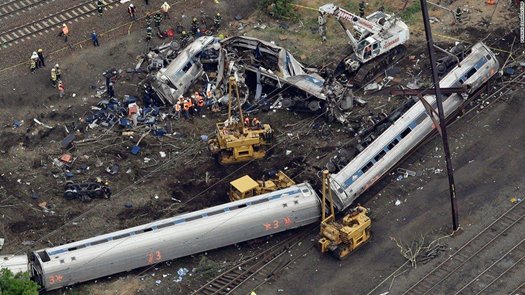In the recent New York Times article “The Wreck of Amtrak 188” Federal Railroad Administration leader Sarah Feinberg explained the advantages of the rail safety technology known as positive train control (PTC).
“I’ll describe it to you this way,” Feinberg said. “If a train is traveling in an area where P.T.C. isn’t in place and working as a backstop, you’ve got a situation where an engineer has to execute everything perfectly every hour, every day, every week. All the time. Because the slightest, smallest lapse can mean disaster.”
The general consensus is that the Amtrak 188 train crash — which caused eight fatalities — would have been avoided if positive train control was in place. The system would have slowed the train automatically so that it didn’t head into a hard curve going much too fast.
But despite the fact PTC was first recommended as a safety measure by the National Transportation Safety Board in 1970, the railroads have failed to install positive train control. So the smallest lapse can mean disaster.
In 2008, after decades of making no progress in getting the railroads to install PTC, Congress mandated that the rail industry implement positive train control by the end of 2015.
However, after having seven years to install PTC, the rail companies threatened to shut down at the end of 2015, claiming the mandated timeline was impossible. So Congress granted a three-year extension.
At the time, Sarah Feinberg made it clear that the Federal Railroad Administration intended to “aggressively enforce” the new deadline for installation of positive train control.
Despite this tough talk, only a couple of months later several rail companies have now asked for an additional two years to implement PTC. This coalition pushing for the status quo includes two major oil-by-rail shippers — CSX and Norfolk Southern.
In response, Feinberg stated that, “We remain concerned that several other freight and passenger railroads are aiming for 2020.”
So we have moved from “aggressive enforcement” to “concern” and more delays.
As reported by the Associated Press, Feinberg’s efforts are limited because “the industry’s allies responded by quietly slipping a provision into a transportation bill in November that limits her ability to deny waivers.”
So while Feinberg promised to aggressively enforce the three-year extension, “industry allies” in Congress took away that option.
Just as they used the same transportation bill to potentially remove the new regulations requiring oil trains to install modern braking systems by 2021.
This is just one more instance making it clear that regulators in Washington really aren’t the ones calling the shots. That helps explain why a safety technology first recommended in 1970 won’t be in place until 2020 at the earliest.
A recent report on rail safety by the Association of American Railroads comments on the status of positive train control:
“The additional time afforded by Congress is critical, because when it is up and running, PTC must operate flawlessly. If it does not, it has the potential to bring freight rail operations to a halt. At present, there is much work to do to iron out the kinks.”
Of course it mentions that there is the potential to shut down the railroads. This is the industry’s standard trump card when it wants to delay or deny responsibility for common-sense safety improvements.
Don’t be surprised to see the industry play this trump card again in 2018.
And how about those “kinks” that need to be ironed out?
This technology was first recommended almost 50 years ago. Shouldn’t the kinks have been addressed by now?
While it looks like we can forget about “aggressive enforcement” when it comes to rail safety, we all probably should “remain concerned.”
Especially as crude oil “bomb trains” continue to roll through communities and cities with inadequate safety measures in place to stop another Lac Megantic-scale disaster.
Image credit: National Transportation Safety Board – Preliminary Report: Railroad DCA15MR010 (released June 2, 2015), Public Domain
Subscribe to our newsletter
Stay up to date with DeSmog news and alerts







